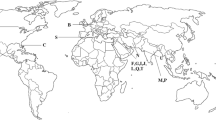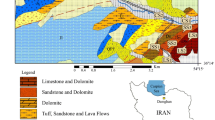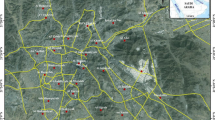Abstract
To ascertain possible relationship between p-wave velocity (Vp), depth and shear strength parameters of remoulded geological materials, 10 locations were each drilled to 60 m depth for downhole seismic data acquisition and also to recover geological materials. The acquisition was to determine lithoseismic zones in each location while the material emanating from each zone was subjected to sieve/sedimentation test to determine their grain-size gradation and further subjected to undrained triaxial test to determine their shear strength parameters—cohesion (c) and internal friction angle (ɸ). The seismic acquisition revealed that most of the locations have 3 lithoseismic zones. Vp of the shallowest weathered zone, middle sub-weathered zone and deep unweathered zone ranges from 351 to 629 m/s, 830 to 1198 m/s and 1569 to 1974 m/s, respectively. The remoulded materials are made of mostly sand and fine particles. The weathered zone materials have c and ɸ ranging from 24.00 to 79.50 kPa and 19.8 to 33.67°, respectively; the sub-weathered zone materials have c and ɸ ranging from 36.00 to 108.00 kPa and 19.04 to 30.26°, respectively, while the unweathered zone materials have c and ɸ ranging from 67.50 to 99.00 kPa and 14.30 to 26.72°, respectively. In each location, c of the remoulded materials increases from the shallow zone to the deep zone just as the Vp. Depth has higher control to Vp of weathered zone than compaction. Holistically, cohesion (c) of the remoulded materials has a derived relationship with both Vp and ‘significant depth’ of the lithoseismic zones. These relationships are valid only for non-ferruginous materials.











Similar content being viewed by others
References
Adegoke OS, Agumanu AE, Benkhelil MJ, Ajayi PO (1986) New stratigraphy, sedimentologic and structural data on the Kerri-Kerri Formation, Bauchi and Borno States. Nigeria J Afr Earth Sci 5(3):249–277
Altindag R (2012) Correlation between P-wave velocity and some mechanical properties for sedimentary rocks. J South Afr Inst Min Metall 112:229–237
ASTM D5783–18 (2018) Standard guide for use of direct rotary drilling with water-based drilling fluid for geoenvironmental exploration and the installation of subsurface water-quality monitoring devices. ASTM International, West Conshohocken, PA. https://doi.org/10.1520/D5783-18
ASTM (American Society of Testing and Materials) (2000) Standard test method for unconfined strength of intact rock core specimens. ASTM Standard D2938-95. West Conshohocken, PA
ASTM (American Society of Testing and Materials) (2002) Standard test method for laboratory determination of pulse velocities and ultrasonic elastic constants of rock: ASTM Standard D2845–83. ASTM, West Conshohocken
ASTM D2850–15 (2015) Standard test method for unconsolidated undrained triaxial compression test on cohesive soils. ASTM International, West Conshohocken.https://doi.org/10.1520/D2850-15
ASTM D6913, D6913M-17 (2017)Standard test methods for particle-size distribution (gradation) of soils using sieve analysis. ASTM International, West Conshohocken.https://doi.org/10.1520/D6913_D6913M-17
ASTM D7400, D7400M-19 (2019) Standard test methods for downhole seismic testing. ASTM International, West Conshohocken. https://doi.org/10.1520/D7400/D7400M-19
ASTM D7928–17 (2017) Standard test method for particle-size distribution (gradation) of fine-grained soils using the sedimentation (hydrometer) analysis. ASTM International, West Conshohocken.https://doi.org/10.1520/D7928-17
Awang H., Ahmad Rashidi N.R., Yusof1 M. and Mohammad K. (2017) Correlation between p-wave velocity and strength index for shale to predict uniaxial compressive strength value. MATEC Web of Conferences 103, 07017, ISCEE 2016 DOI: https://doi.org/10.1051/matecconf/201710307017.
Bar N, Barton N (2017) The Q-slope method for rock slope engineering. Rock Mech Rock Eng. 50(12):3307–3322. https://doi.org/10.1007/s00603-017-1305-0
Bery AA, Saad R (2012) Correlation of seismic p-wave velocities with engineering parameters (N value and rock quality) for tropical environmental study. Inter J Geosci 3:749–757
Dike EFC (1995) Stratigraphy and structure of the Kerri-Kerri Basin. North-Eastern Nigeria J Min Geol 29:77–93
El-Emam MM, Khan ZH and Mohammad O, Amer MO (2019) Effect of water content, void ratio and clay content on sand p-wave velocity. Proceedings of the 4th World Congress on Civil, Structural, and Environmental Engineering (CSEE’19). Paper No. ICGRE 175. Rome, Italy. https://doi.org/10.11159/icgre19.175
Faust LY (1951) Seismic velocity as a function of depth and geologic time. Geophys 16(2):192–206
Gardner GHF, Gardner W, Gregory R (1974) Formation velocity and density—the diagnostic basics for stratigraphic traps. Geophys 39:770–780
Garg SK (2011) Geotech engineering: soil mechanics and foundation engineering, eight. Khanna Publishers, Daryaganj, New Delhi, p 1333
Goodfellow BW, Chadwick OA, Hilley GE (2014) Depth and character of rock weathering across a basaltic hosted climosequence on Hawai ‘i. Earth Surf Process Landf 39(3):381–398
Han DH, Batzle M (2004) Gassmann’s equation and fluid-saturation effects on seismic velocities. Geophys 69:398–405
Han DH, Nur A, Morgan D (1986) Effects of porosity and clay content on wave velocities in sandstones. Geophys 51:2093–2107
Hicks WG, Berry JE (1956) Application of continuous velocity logs to determination of fluid saturation of reservoir. Geophys 21:739–754
IDSL/BGP JV-409 (2019) Integrated Data Service Limited (IDSL) & Bureau of Geophysical Prospecting (BGP) Joint Venture-409 Downhole/Uphole Data Acquisition Method. Unpublished Method prepared for seismic data acquisition submitted to Frontier Exploration Services (FES).
Igwe CA, Zarei M, Stahr K (2009) Colloidal stability in some tropical soils of southeastern Nigeria as affected by iron and aluminium oxides. CATENA 77:232–237. https://doi.org/10.1016/j.catena.2009.01.003
Jamshidi A, Khamehchiyan NMR, M, Sahamieh RZ, Abdi Y, (2016) A correlation between P-wave velocity and Schmidt hardness with mechanical properties of travertine building stones. Arab J Geosci 9:568. https://doi.org/10.1007/s12517-016-2542-3
Kahraman S (2001) Evaluation of simple methods for assessing the uniaxial compressive strength of rock. Int J Rock Mech Min Sci 38:981–994
Kahraman S (2002) The effects of fracture roughness on P-wave velocity. Eng Geol 63:347–350
Kassab MA, Weller A (2013) Porosity estimation from compressional wave velocity: a study based on Egyptian carbonate samples. J Earth Sci Eng 3:314–321
Kassab MA, Weller A (2015) Study on P-wave and S-wave velocity in dry and wet sandstones of Tushka region. Egypt Egypt J Pet 24:1–11
Kottek M, Grieser J, Beck C, Rudolf B, Rubel F (2006) World map of the Koppen-Geiger climate classification updated. Meteorol Z 15(3):259–263
Kurtulus C, Bozkurt A, Endes H (2012) Physical and mechanical properties of serpentinized ultrabasic rocks in NW Turkey. Pure Appl Geophys 169:1205–1215
Kurtulus C, Irmak TS, Sertcelik I (2010) Physical and mechanical properties of Gokceada: Imbros (NE Aegean Sea) island andesites. Bull Eng Geol Environ 69:321–324
Lohnes RA, Demirel T (1973) Strength and structure of laterites and lateritic soils. Eng Geol 7(1):13–33
Maigari AS, Obaje NG, Haruna AI, Isa MT (2005) Mineralogy and geochemistry of some clays of the Kerri-Kerri Formation in the upper Benue Trough. North-Eastern Nigeria Res J Sci 11:17–30
Maria L, Marcos F, Buurman P, Maijer EL (2008) Role of organic matter and sesquioxides on variable charge of three soils from Galicia. Spain Commun Soil Sci Plant Anal 29(15/16):2441–2457
Minear MJ (1982) Clay models and acoustic velocities. Pres. 57th Ann. Mtg. Trans of American Institute of Min. Metall. Eng., New Orleans
Moradian OZ, Behnia M (2009) Predicting the unconfined compressive strength and static young’s modulus of intact sedimentary rocks using the ultrasonic tests. Int J Geomech 9:1–14
Nespereira J, Navarro R, Monterrubio S, Yenes M, Pereira D (2019) Sustainability serpentinite from moeche (Galicia, North Western Spain). A stone used for centuries in the construction of the architectural heritage of the region. Sustainability 11:2700
Obaje NG, Attah DO, Opeloye SA, Moumouni A (2006) Geochemical evaluation of the hydrocarbon prospects of sedimentary basins in Northern Nigeria. Geoch J 40:227–243
Ojha M, Sain K (2014) Velocity-porosity and velocity-density relationship for shallow sediments in the Kerala-Konkan basin of Western Indian Margin. J Geol Soc India 84:187–191
Onoduku US, Okosun EA, Akande WG (2013) An assessment of the hydrocarbon potential of the Gombe Formation, Upper Benue Trough, Northeastern Nigeria: organic geochemical point of view. Earth Sci Res 2(2):203–213
Peel MC, Finlayson BL, McMahon TA (2007) Updated world map of the Koppen-Geiger climate classification. Hydrol Earth Sys Sc 11:1633–1644
Popoff M, Wiedmann J, De Klasz I (1986) The Upper Cretaceous Gongila and Pindiga Formations, northern Nigeria: subdivision, age, stratigraphic correlations and paleogeographic implications. Eclogae Geol Helv 79:343–363
Press F. (1966) Seismic velocities. 195–218. In Clarke, S. P. JR. (Ed.): Handbook of physical constants-revised edition. Geological Society of American Memoir 97. 587p.
Rahman T, Sarkar K (2021) Lithological control on the estimation of uniaxial compressive strength by the p-wave velocity using supervised and unsupervised learning. Rock Mech Rock Eng 54:3175–3191. https://doi.org/10.1007/s00603-021-02445-8
Rahman T, Sarkar K, Singh AK (2020) Correlation of geomechanical and dynamic elastic properties with the P-wave velocity of Lower Gondwana coal measure rocks of India. Int J Geomech. 20(10):04020189. https://doi.org/10.1061/(ASCE)GM.1943-5622.0001828
Romana M (1985) New adjustment ratings for application of Bieniawski classification to slopes; In: Proceedings of International Symposium on Role of Rock Mech, ISRM, Zacatecas, Mexico. Pp 49–53
Salah MK, Alqudah M, Abd El-Aal AK, Barnes C (2018) Effects of porosity and composition on seismic wave velocities and elastic moduli of lower cretaceous rocks, central Lebanon. Acta Geophys 66(5):867–894
Selçuk L, Nar A (2016) Prediction of uniaxial compressive strength of intact rocks using ultrasonic pulse velocity and rebound-hammer number. Q J Eng Geol Hydrogeol 49(1):67–75
Sharma PK, Singh TN (2008) A correlation between P-wave velocity, impact strength index, slake durability index and uniaxial compressive strength. Bull Eng Geol Environ 67:17–22
Telford WM, Geldart LP, Sherriff RE, Keys DA (1990) Applied geophysics, 2nd edn. Cambridge University Press, Cambridge
Teymen A, Mengüç EC (2020) Comparative evaluation of different statistical tools for the prediction of uniaxial compressive strength of rocks. Int J Min Sci Tech 30(6):785–797
Townsend FC, Manke PG, Parcher JV (1969) Effects of remoulding on the properties of a Laterite Soil. Highw Res Rec 284:76–84
Tuncer ER (1976) Engineering behaviour and classification of lateritic soils in relation to soil genesis. Iowa State University Capstones, Ph.D Retrospect Theses and Dissertations 5712.
Von Voigtlander J, Clark MK, Zekkos D, Greenwood WW, Anderson SP, Anderson RS, Godt JW (2018) Strong variation in weathering of layered rock maintains hillslope-scale strength under high precipitation. Earth Surf Process Landf 43:1183–1194
Xu S, White RE (1995) A new velocity model for clay–sand mixtures. Geophys Prosp 43:91–118
Yin Y, ** FM, Liang CH (2019) Sesquioxides and their contribution to soil aggregation under long-term greenhouse soil management. Commun Soil Sci Plant Anal 50(20):2881–2888
Zaborski PM (1997) Guide to the cretaceous system in the upper part of the upper benue trough. North-Eastern Nigeria Afr Geosci Rev 10(1&2):1322
Zaborski PM (1998) A review of the cretaceous system in Nigeria. Afr Geosci Rev 5(4):385–483
Acknowledgements
Authors are grateful to Petroleum Technology Development Fund (PTDF) for their financial assistance to this research. Authors are also thankful to the Seismology Department of Integrated Data Service Limited (IDSL) and Bureau of Geophysical Prospecting (BGP) Joint Venture-409 Seismic Crew that provided the drilling equipment used in drilling the wellbores and seismograph used for seismic data acquisition. Authors sincerely appreciate the anonymous reviewers and editor to this publication whom suggestions/recommendations upgraded the paper to this level.
Author information
Authors and Affiliations
Corresponding author
Ethics declarations
Competing interests
The authors declare no competing interests.
Additional information
Responsible Editor: Zeynal Abiddin Erguler
Rights and permissions
About this article
Cite this article
Ugwoke, T.A.S., Igwe, O. & Emeh, C. Empirical relationship of p-wave velocity, depth and shear strength parameters of remoulded geological materials from a sedimentary terrain in North-eastern Nigeria. Arab J Geosci 15, 315 (2022). https://doi.org/10.1007/s12517-022-09507-3
Received:
Accepted:
Published:
DOI: https://doi.org/10.1007/s12517-022-09507-3




